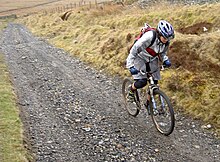 Mountain biking and paddle boarding
Mountain biking and paddle boarding
The sport requires endurance, core strength and balance, bike handling skills, and self-reliance. Advanced riders pursue both steep technical descents and high incline climbs. In the case of freeride, downhill, and dirt jumping, aerial maneuvers are performed off both natural features and specially constructed jumps and ramps.
Mountain bikers ride on off-road trails such as singletrack, back-country roads, fire roads, and often venture to ski resorts that stay open in the summer for such activities. Because riders are often far from civilization, there is a strong ethic of self-reliance in the sport. Riders learn to repair broken bikes and flat tires to avoid being stranded. Many riders carry a backpack, including water, food, tools for trailside repairs, and a first aid kit in case of injury. Group rides are common, especially on longer treks. Mountain bike orienteering adds the skill of map navigation to mountain
- Mountain bikes differ from other bikes primarily in that they incorporate features aimed at increasing durability and improving performance in rough terrain. Most modern mountain bikes have some kind of suspension, 26, 27.5 or 29-inch diameter tires, usually between 1.7 and 2.5 inches in width, and a wider, flat or upwardly-rising handlebar that allows a more upright riding position, giving the rider more control. They have a smaller, reinforced frame, usually made of wide tubing. Tires usually have a pronounced tread and are mounted on rims which are stronger than those used on most non-mountain bicycles. Compared to other bikes, mountain bikes also tend to more frequently use hydraulic disc brakes. They also tend to have lower ratio gears to facilitate climbing steep hills and traversing obstacles. Pedals vary from simple platform pedals, where the rider simply places the shoes on top of the pedals, to clipless, where the rider uses a specially equipped shoe with a cleat that engages mechanically into the pedal. Mountain biking is the sport of riding bicycles off-road, often over rough terrain, using specially designed mountain bikes. Mountain bikes share similarities with other bikes but incorporate features designed to enhance durability and performance in rough terrain. Mountain biking can generally be broken down into multiple categories: cross country, trail riding, all mountain (also referred to as "Enduro"), downhill, freeride and dirt jumping. However, the majority of mountain biking falls into the categories of Trail and Cross Country riding styles.
n biking. How Mountain Biking Works
How Mountain Biking Works
 How Mountain Biking Works
How Mountain Biking Works
Mountain biking can be performed on any off-road surface. While mountain trails are among the most popular spots, bikers also flock to deserts and national parks to add some variety to their routine. This sport is popular not only in North America but also in Europe and much of Asia. Destination mountain biking provides an opportunity to explore further fields as bikers travel the globe looking for the next great trail.
While racing and thrills are easy to find in this sport, mountain biking actually encompasses a number of various divisions aimed at different types of riders and interest levels. Cross-country biking is the most popular and involves rides on mountain trails of all shapes and sizes. There's less emphasis on speed and tricks and a greater focus on variety and all-around enjoyment of the sport. Downhill riders are those seeking thrills in the form of fast descents. Many downhill riders use vehicles or lifts to reach the peak of the mountain before racing back to the bottom by bike. Freestyle riders perform more technical riding, including jumps and other tricks, while participants in mountain bike orienteering use compasses and GPS systems to navigate the backcountry as they ride. As this sport expands, additional disciplines are sure to follow. Paddleboarding
A related, traditional sport, paddleboarding, is done kneeling on a board and paddling with the hands, similar to a butterfly swimming stroke. The term “kooks" is sometimes incorrectly used to refer to stand up paddle surfing.
Historian and writer Steve West claimed that the contemporary notion of stand up paddle boarding, if attributed to the Waikiki Beach Boys of Oahu during the 1960s, considers that outrigger canoeing should be recognized as the direct link between the idea of standing on a board and propelling it with a canoe paddle, since the individual SUP skills (board riding and paddling) already existed, used by people who had traditionally grown up learning them



No comments:
Post a Comment